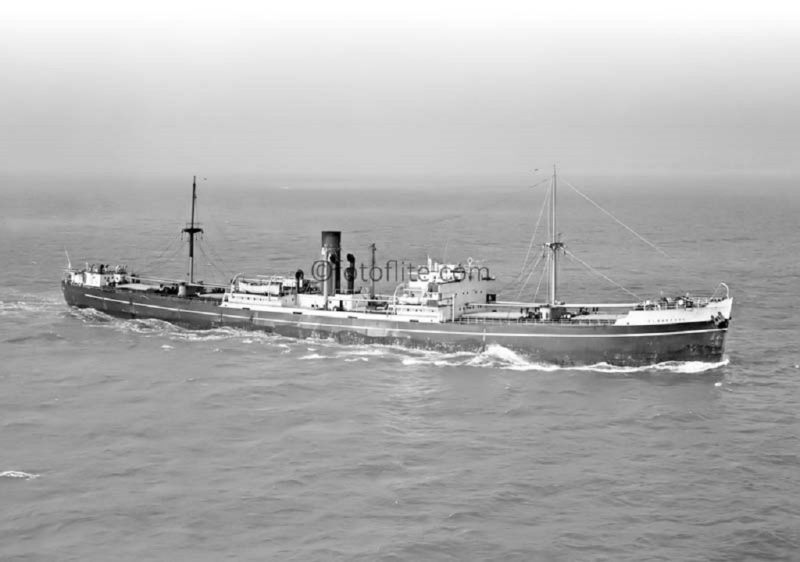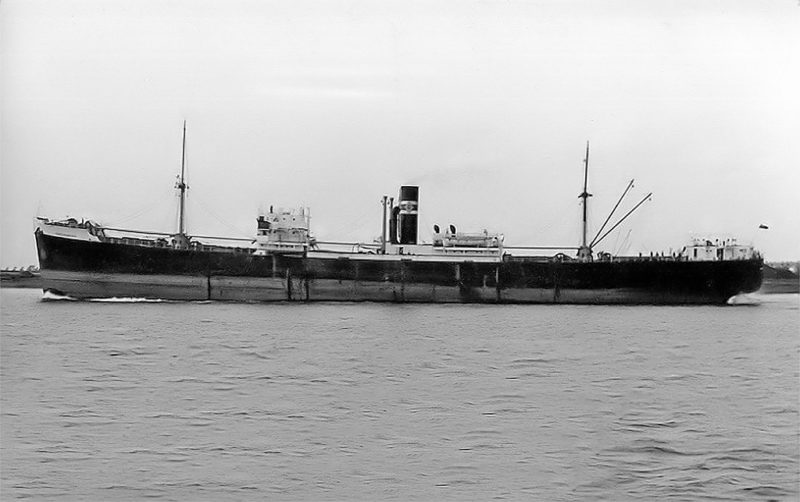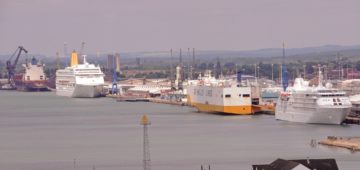
It is interesting to see just how far reaching and diverse the voyages of a tramp steamer in the 1940 and 1950s could be. Associated with these lengthy voyages, with apparent minimum maintenance, were the trials, tribulations and dangers associated with sailing the seven seas of the world.
This is the almost 10 year career of the ss. Clearpool during her time with the Pool Shipping Company (Ropner Management) following her purchase from the Ministry of War Transport in December 1945 to her sale in February 1955.
Wm. Gray and Co. of West Hartlepool built Clearpool on behalf of the Ministry of War Transport. The vessel was a Standard War Built Empire Ship, originally named Empire Cabot. She was a standard ”Y” TYPE tramp steamship, measuring 432 feet (oa) with a beam of 57 feet with a gross tonnage of 6,715, and deadweight of 9,744 tons. Coal fired triple expansion engines built by Central Marine Engineering Works, West Hartlepool gave her a speed of about 10 knots.
Empire Cabot was yard No 1118 and official number 168929 with signal letters BCPM, she was launched on the 9th July 1941 and completed the following September.
Initially placed under the management of Glen and Co. Ltd., her first voyage was with convoy ON19 leaving Liverpool on the 21st September 1941 to Loch Ewe to sail in ballast for Tampa, Florida. However shortly after sailing she lost contact with the convoy in heavy fog and returned to Loch Ewe, eventually departing on the 30th September for Hampton Roads.
The management of Empire Cabot was handed over to Ropners in 1942, who also eventually incorporated the war built, Wm. Gray built sisters, Empire Sunbeam, Empire Clarion, Empire Lionel, and Empire Irving into their fleet.
Other Standard Y TYPE vessels managed by the company, but lost to enemy action during the war included, Empire Dryden, (Wm. Doxford, Sunderland), on the 20th April 1942. Empire Rainbow, (Greenock Dockyard) on the 26th July 1942 and Empire Arnold (Wm. Gray) on the 4th August 1942.
Empire Cabot was acquired under the government purchase scheme, and went some way to replacing the horrendous losses suffered by the company during the Second World War. The vessel was taken over at Greenock on the 19th December 1945 and renamed Clearpool, the third vessel in the fleet to carry the name. Her predecessor, also built by Wm. Gray and Co. and completed in 1935, was wrecked on Skitter Sands in 1944. after sailing from Hull. The Humber pilot onboard was held to have been responsible for her stranding at the subsequent enquiry.
Captain F. Tate was her first master after renaming. He had been captain of her sister ship Empire Arnold when torpedoed by U-155 under the command of Kapitanleutnant Adolf Piening on the 4th August 1942 off the north coast of South America.
Empire Arnold was in convoy EF6 from New York via, Trinidad, Cape Town and the Suez Canal to Alexandria. Captain Tate was taken on board the U-Boat and eventually became a prisoner of war after being landed at Lorient on the 15th September 1942. He was interned at Milag Nord, Westermtimke camp until his release in 1945.
Nine crewmembers were lost from Empire Arnold, the survivors being picked by the Norwegian ship Dalvanger and landed in New Guinea.
U-155 went on to sink the Royal Navy Escort Aircraft Carrier HMS Avenger off Gibraltar on the 15th November 1942. The submarine survived the war being surrendered and then scuttled off the coast of Ireland under Operation Deadlight in 1945/46.
Clearpool was engaged in general tramping throughout 1946 and in February 1947 she was caught up in the big freeze of the time, taking 30 days to discharge her cargo of iron ore in Tyne Dock. There were no railway trucks available to take her cargo, all being fully utilised in the carriage of coal to keep the country warm and power stations running.
On the 1st March 1947 Clearpool was chartered to the Australian Shipping Board and sailed in Pacific waters until she was re-delivered on the 4th December 1948 and sailed back to the UK departing on the 15th February 1949.
From December 1949 to January 1950, along with the company’s other vessels, Seapool and Swainby, Clearpool was berthed in Vancouver, however all were unable to sail because of unusually cold weather and the danger posed by ice.
Sailing back to the UK via the Panama Canal, Clearpool was converted to burn oil fuel at North Shields, the conversion being completed on the 20th July 1950. Following her conversion she was fixed to carry coal from the Humber to Civitavecchia, Bona and back to the UK.
Clearpool then returned to Pacific waters, and on the 6th January 1951 her Radio Officer, Mr. E. Wrightson died onboard whilst the vessel was in the Japanese port of Hakodate. During the voyage from Nagoya a mild epidemic of influenza had broken out onboard, a number of crew members being laid up for several days. A severe storm, followed by freezing weather, appears to have made the condition of the radio officer worse, and as a result he succumbed to his illness. The vessel was detained in Yokohama when US authorities refused to allow a Japanese radio officer to sail with the ship to Vancouver. Another Marconi Marine radio officer had to be transferred from a Royal Fleet Auxiliary in Hong Kong and flown to Yokohama (at company expense) before Clearpool was allowed on her way.
The vessel then made her way down the US West coast and through the Panama Canal, and on the 24th May 1951 along with her sister Cedarpool (ex Empire Clarion) began loading a cargo in Galveston for India. Both ships sailed on the 29th May, Cedarpool making the slightly faster passage averaging 10.82 knots, Clearpool making 9.94 knots.
On 31st July 1951 Clearpool was in the Indian port of Vizagapatam when she was hit by lightning during a particularly heavy thunderstorm. As a result the top of the mainmast was broken off, however the carpenter onboard carried out repairs and the ship was not delayed.

Clearpool then made her way down to the Australian coast, and when on the return leg in ballast to the US west coast, called at Honolulu for bunkers. This was the first time a Ropner vessel had called at the Hawaiian Island, although Sedgepool also called for bunkers a short time later.
Making her way back to the UK for Christmas, Clearpool again passed through the Panama Canal en-route to Immingham. However whilst in the North Atlantic she sailed through three gales, each more severe than the previous one. Her deck cargo shifted and at one point the ship had a 42 degree list, and she had to limp into Plymouth to discharge her cargo, which was taken on to Immingham by rail. All her lifeboats were damaged, and the hospital door was wrenched off its hinges and driven through the bulkhead into the 3rd Mates cabin.
Following repairs Clearpool left the Humber in February 1952 in ballast on time charter to Norfolk Va., again running into heavy weather during the westbound voyage. On her return to Rotterdam, she experienced more gales and lost the 2nd Mate, Mr. W.M. Anderson, overboard on the 28th February. Heavy seas carried away part of the lower bridge along with the unfortunate 2nd Officer. The captain was unable to turn the ship around due to the mountainous seas, and danger of capsizing the vessel. Extensive damage was caused to the decks along with the superstructure, and the accommodation was flooded. Most of the crew paid off following her arrival at Rotterdam in March.
The following month Clearpool’s troubles continued when she grounded in the River Elbe, requiring the assistance of two tugs to pull her free, both of which claimed salvage. Although the pilot was blamed for the grounding the directors of the company took a dim view and the captain, who was not a company contract officer, but from the Merchant Navy Pool, was required to relinquish his command he was replaced with a company contract master.
The remainder of 1952 appears to have passed by more peacefully, and January 1953 found Clearpool in the West African port of Lagos, where she was victim of a crime, having 6 tarpaulins, a coil of 2.5-inch rope and separation cloths stored in the forecastle stolen. It was noted in the log that the police failed to identify the culprit.
September and October 1953 saw Clearpool back in the northern Pacific and whilst en route for Osaka experienced severe weather as was never seen before. This severity of weather appears to follow the vessel around wherever she sailed. When Clearpool left Osaka the ship was in ballast and the seas were so high as a result of the typhoon raging at the time, the captain considered flooding the holds to put the ship lower in the water. However the vessel managed to ride out the storm, and this drastic action was not necessary.
Clearpool arrived back to the UK for Christmas 1953, arriving at Gravesend on the 20th December. This was somewhat fortunate as the master, Captain J. H. Atkinson, was due to give his daughter away at her wedding on Boxing Day!
On the 18th January 1954 Clearpool arrived at the Ropner Gulf Line berth in the Thames to load a cargo for the United States, followed by a return voyage to the UK.
Further round voyages continued, and she again docked in the Thames on the 6th April 1954 discharged, and then loaded sailing for Miami on the 21st April.
About this time the company let it be known that they were considering the sale of the ship and in July 1954 she underwent repairs and dry-docking with an interest being shown in her purchase. However this sale fell through and Clearpool continued as an active vessel in the Ropner Fleet.
Continuing on the UK to US round voyages, in October, two days out of New York the vessel sprung a leak through the auxiliary condenser discharge valve box. Temporary repairs were carried out and a collision mat blocked the hole. Clearpool put into Bermuda on the morning of 29th October sailing two days later after repairs.
After sailing from Bermuda, Clearpool again experienced very rough North Atlantic weather, taking 21 days to reach Rotterdam. The ship sustained more heavy weather damage and it was with a certain amount of relief when she entered port.
To compound matters during the long rough voyage, the 2nd Engineer, whilst chipping rust in the engine room, sustained an injury to an eye. A piece of metal a quarter of an inch long was eventually removed from his eye, and it was noted that, despite of being in terrific pain, he continued with his duties.
After making a number of further round transatlantic voyages, the ship was sold and handed over to new owners at Rotterdam on the 8th February 1955.
Her owners were the Cardigan Shipping Company, (W.T. Gould & Co.) who renamed her Grelmarion. The vessel served this company until sold in 1959 to Robert M. Sloman Jnr. of Germany who renamed her Rachel. They sailed the vessel to Hong Kong for scrap, and she was broken up there by Shui Wing Co. Ltd. in November 1959.
So ends the story of a Ropner tramp, and shows the distances travelled and the dangers faced. Wm. Gray and Co. Ltd., of West Hartlepool built many of the Ropner pre-war ships and being based in that port Ropners were an obvious choice to manage the standard war built ships constructed in that yard on behalf of the Government.
Clearpool was the first of the five to be sold, followed by Cedarpool (ex Empire Clarion) for scrap in 1959. Bellerby (ex Empire Irving) was sold for further trading in 1960 and Swainby (ex Empire Sunbeam) and Levenpool (ex Empire Lionel) were both being sold in 1962 to Tsavliris (Shipping) Ltd. for further trading.
The Ropner offices were moved on a temporary basis to the inland town of Sedgefield at the start of the Second World War, as it was felt that they were safer from German bombs or shelling as had happened in the First World War.
After the end of the Second World War the company moved permanently further inland to Darlington where they remained until the 1990s and then for a short time to Thornaby at Stockton on Tees until the firm ceased trading in 1997/98





Comments
Sorry, comments are closed for this item